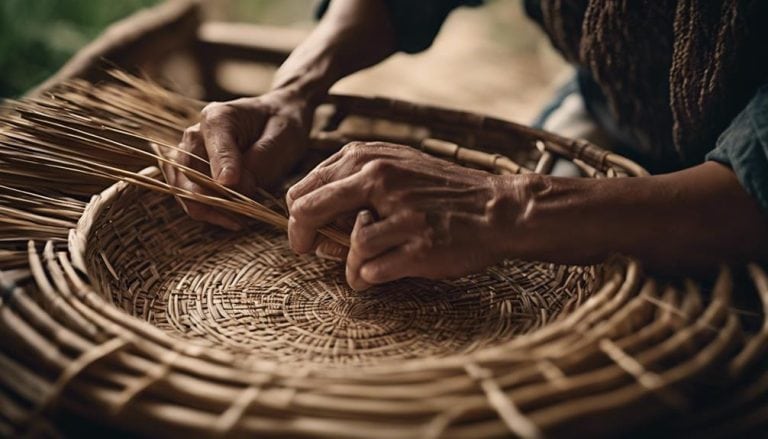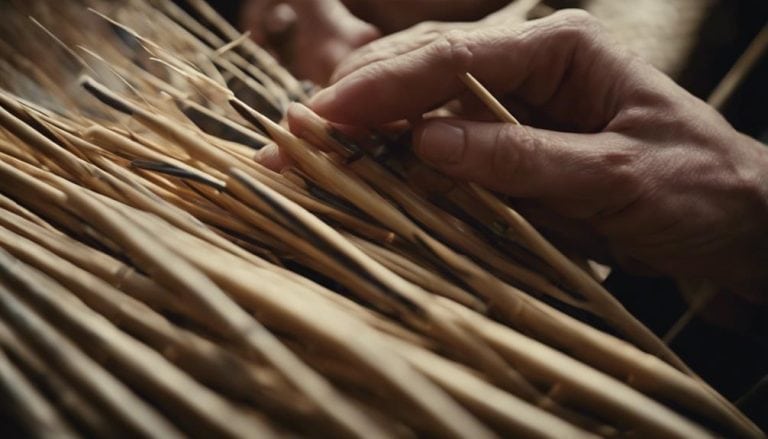Understanding the Use of Rush Reeds in Basketry
As I carefully observed the rush reeds swaying in the gentle breeze, it struck me how their flexibility mirrors the adaptability needed in the intricate art of basket weaving. How rush reeds intertwine to form sturdy structures is nothing short of mesmerizing. Exploring the depths of this ancient craft unveils a world where tradition meets innovation, where natural materials become vessels of creativity.
Join me as we unravel the secrets behind the centuries-old technique of using rush reeds in basketry. This journey promises to open doors to a realm of artistry intertwined with nature’s bounty.
In basketry, rush reeds are vital for weaving due to their flexibility and strength, enhancing the durability and beauty of woven creations. Their flexibility and resilience make rush reeds preferred for intricate basket designs.
Key Takeaways
- Rush reeds in basketry hold historical, cultural, and practical significance.
- They offer sustainability, durability, and flexibility in basket weaving.
- Various rush reed types cater to different basketry needs.
- Mastering rush reed techniques preserves heritage and supports artisans.
The Origins of Rush Reeds
The historical roots of rush reeds in basketry can be traced back to ancient civilizations, notably flourishing in the artistry of ancient Egypt. Ancient techniques for weaving with rush reeds were developed and refined over centuries, demonstrating this practice’s intricate craftsmanship and cultural significance. Ancient Egyptians used these versatile materials to create a wide array of baskets for everyday use and ceremonial purposes in wetland areas where rush reeds grew abundantly.
The flexibility of rush reeds allowed artisans to weave intricate patterns and shapes, showcasing their skill and creativity in basket making. The cultural significance of rush reeds in ancient Egypt extended beyond mere utility; these baskets played a vital role in daily life, from storing food to carrying goods.
The art of weaving with rush reeds was a revered tradition, passed down through generations, preserving both the techniques and the cultural heritage associated with this craft. The intricate patterns and designs crafted from rush reeds reflected the artistic sensibilities of ancient Egyptian society, highlighting the importance of craftsmanship and creativity in their culture.
Benefits of Using Rush Reeds

Exploring the practical advantages of incorporating rush reeds in basket weaving reveals many benefits that enhance both the functionality and aesthetics of the final woven products.
- Environmental Impact and Longevity: Rush reeds offer a sustainable alternative to synthetic materials, reducing the ecological footprint of basket weaving. Their durability ensures that the baskets created with rush reeds can withstand the test of time, providing long-lasting utility while being gentle on the environment.
- Artistic Possibilities and Cultural Significance: Rush reeds’ natural colors and textures add a unique and rustic charm to woven baskets, allowing artisans to create visually appealing pieces with cultural significance. These reeds enhance the artistic value of the baskets and connect the craft to traditions and histories, making each piece a story.
- Functionality: Rush reeds’ lightweight and flexible nature makes them easy to work with, enabling weavers to create intricate designs and shapes in their baskets. Additionally, the hollow structure facilitates good air circulation within the baskets, making them ideal for storing fruits and vegetables, enhancing their functionality beyond aesthetics.
Types of Rush Reeds Available

Among the various rush reeds utilized in basket weaving, soft rush, and bullrush are prominent choices due to their distinct characteristics and applications in creating diverse basketry projects. Soft rush, known for its flexibility, is ideal for coiling and intricate weaving patterns, producing delicate and detailed designs.
On the other hand, bullrush, with its thicker and sturdier stem, lends itself well to crafting robust baskets or providing structural support in larger projects. These rush reeds offer a range of color variations, from pale yellows to deep greens, adding visual interest to the final creations. The different weaving patterns achievable with these reeds allow for artistic expression and functional versatility. The table below summarizes the key features of soft rush and bullrush:
| Rush Reed Type | Characteristics |
|---|---|
| Soft Rush | Flexibility, Delicate designs, Various colors |
| Bullrush | Sturdiness, Structural support, Color variations |
Understanding the unique qualities of each rush reed type enables artisans to select the most suitable material for their basket weaving endeavors, resulting in beautifully crafted pieces that reflect both form and function.
Techniques for Working With Rush Reeds
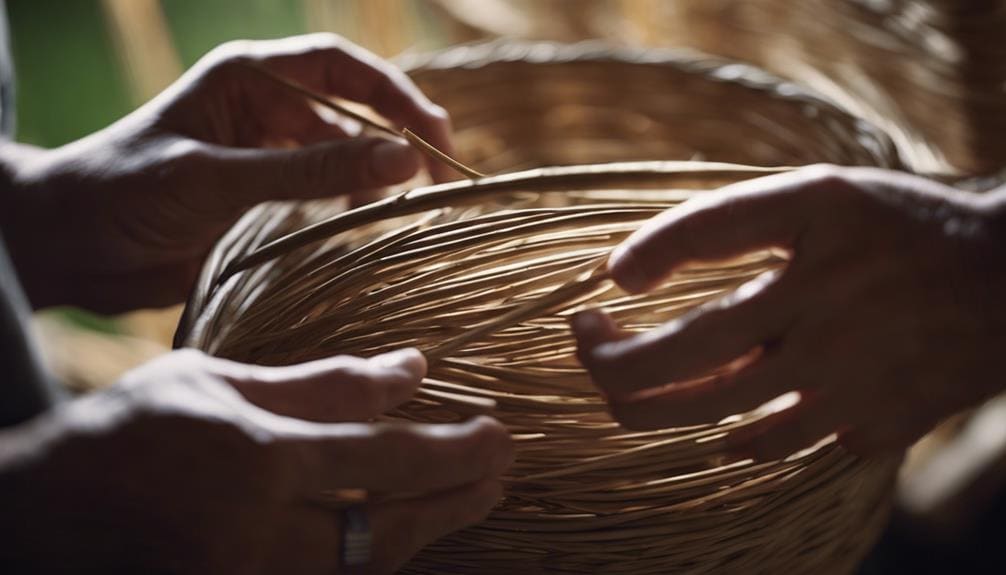
Utilizing a wetting process enhances the flexibility of rush reeds, facilitating their manipulation and integration into basket-weaving projects. Soaking the rush reeds in water before starting a project is essential to make them more flexible and easier to weave.
Starting from the base of the basket and using an over-under weaving technique ensures a sturdy foundation for the basket structure. Securing the ends of the rush reeds can be done by tucking them under previous rows or tying them off tightly, maintaining the integrity of the weave.
Enjoyable Techniques for Working With Rush Reeds:
- Begin with a Wetting Ritual: Soaking the rush reeds in water increases their flexibility and adds a meditative aspect to the weaving process.
- Embrace Creative Weaving Patterns: Experiment with different weaving patterns using rush reeds of varying thicknesses to create unique textures and designs.
- Finish with Precision: Trim any excess rush reeds neatly to give the basket a polished and professional appearance.
Design Inspiration With Rush Reeds
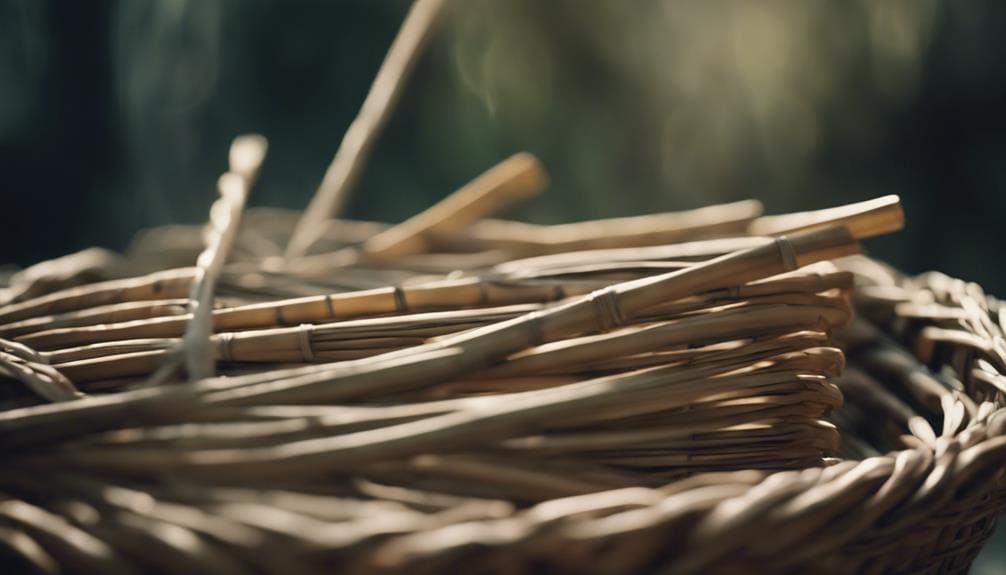
Immersing rush reeds in natural dyes can infuse vibrant colors into basket designs, adding a creative dimension to the weaving process. The interplay of colors on rush reeds opens a world of possibilities for creating colorful patterns that evoke different emotions or themes. By experimenting with various dyeing techniques and combinations, artisans can achieve unique, eye-catching designs that stand out.
The flexibility of rush reeds allows for intricate weaving patterns, enabling artisans to craft baskets with mesmerizing details and visual appeal. Combining rush reeds with natural materials like willow or grasses further enhances the creative crafting process, adding texture and depth to the final piece.
Whether twisted, braided, or coiled, rush reeds offer versatility in shaping baskets and creating diverse shapes and structures. Drawing inspiration from traditional Irish basket designs, incorporating rush reeds can honor cultural heritage and showcase the exquisite craftsmanship that goes into each handmade piece.
Maintenance and Care of Rush Reeds Baskets

Drawing on the intricate weaving patterns and vibrant colors discussed in design inspiration with rush reeds, it is essential to understand the maintenance and care required for rush reed baskets to preserve their beauty and longevity.
To ensure your rush reed baskets remain in top condition, consider the following:
- Avoid Sunlight: Protect your rush reed baskets from direct sunlight to prevent fading and weakening of the rushes.
- Gentle Cleaning: To keep the baskets fresh, use a soft brush or cloth to dust off dirt and debris.
- Prevent Drying: Maintain the flexibility of rush reeds by misting them occasionally with water, preventing breakage.
Sustainable Practices in Rush Reeds Basketry
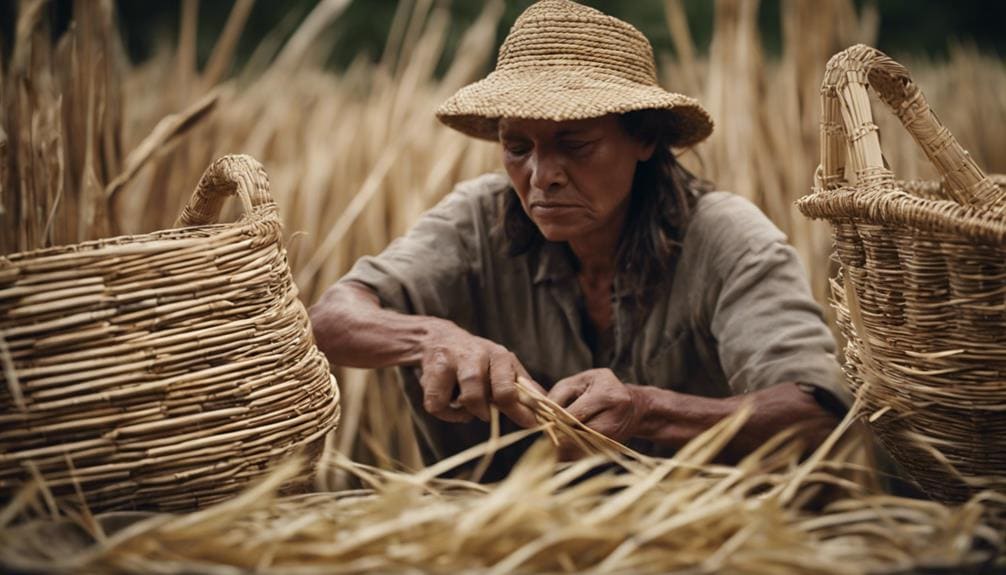
Sustainable practices in rush reeds basketry play a crucial role in ensuring the long-term viability of this traditional craft. Harvesting ethics are fundamental; responsibly gathering rushes ensures plant health and allows for natural regeneration. By only harvesting mature rushes and leaving enough for wildlife and future growth, we support the ecological balance necessary for sustainable harvesting.
Replanting after harvests further aid in maintaining ecosystem stability, ensuring a continued supply of rush reeds for basket weaving. Additionally, using organic and natural dyes reduces chemical pollution, enhancing the craft’s sustainability. Supporting artisans practicing sustainable rush reeds basketry is key; it preserves traditional techniques and fosters community support and local economies. Upholding these sustainable practices benefits the environment and safeguards the livelihoods of artisans and the cultural heritage embedded in rush reeds basketry.
Frequently Asked Questions
What Is the Difference Between Reeds and Rushes?
Reeds are tall and have hollow stems, while rushes are shorter and solid. Reeds are tougher and used for thatching, while rushes have a spongy center, making them ideal for weaving techniques with natural materials like baskets.
How Do You Harvest Rushes for Weaving?
I cut rushes at the base with scissors, seeking clumps in wetland areas with brown flowers. Sorting them by length and thickness, I choose the best for weaving. Their soft foam center makes them ideal for crafting baskets.
How Long to Soak Reeds for Basket Weaving?
I soak reeds for basket weaving to enhance flexibility, ensuring smoother weaving. Adjust soaking times based on reed type. Longer soaking may be needed for thicker reeds. Regularly check flexibility while soaking.
What Can You Make Out of Rushes?
I can transform rushes into stunning pieces through rush weaving techniques. From intricate mats to eco-friendly baskets, my creations embody sustainability and artistry. Rush crafts offer a canvas for my imagination, blending tradition with innovation.
Conclusion
As I gaze upon my beautifully woven rush reeds basket, I can’t help but marvel at the intricate patterns and designs created with these versatile materials. Who knew something as simple as rush reeds could bring joy and creativity into my life? It’s almost as if each basket tells a unique story, weaving together tradition and innovation in a way that captivates the soul. Rush Reed’s basketry truly is a work of art worth exploring.



